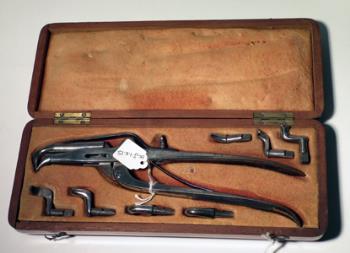- Dutch steel pelican set
- HC.J.1.X.15
- J. Pohl (Manufacturer)
- Steel pelican with 8 interchangable heads (fulcra and claws varying in size and design), by J. Pohl, in a rosewood case. Dated to the 1860s. An extraordinary and formidable all metal modified pelican for the vertical extraction of teeth, complete in original fitted case with four fulcra and five claws varying in size and design. It was invented in 1861 (British patent, 16 Nov) by a French surgeon, Eugene d'Estanque. He submitted it for approval to 'L'Academie Imperiale deMedicine, Bull. Acad' imp. Med.' (1861-2), XXVII, p.166. This body delegated two of its members to furnish a report, which was presented in 1863. It was then explained that the instrument had proved very inconvenient, because of necessitating the use of both hands: and the consequent risk of injuring an adjacent tooth. However, in the interval, d'Estanque had so altered the design that his instrument could be operated with one hand. This ensured the extraction of a tooth in a single movement with a greater degree of accuracy. Johannes Franciscus Josephus Pohl: Dutch scientific instrument maker (1832-70). The Academie highly commended d'Estanque for the ingenuity of his invention, termed Attractif 'Estanque, op. cit. (1862-3), XXVIII, p.335.
- Nineteenth century, mid
Height: Box 16.2 cm










